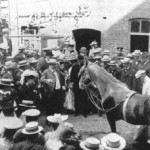Weekly Wrap Volume 64
 Terrifying Fluffy Bunnies and The Little Albert Experiment
Terrifying Fluffy Bunnies and The Little Albert Experiment
The Little Albert Experiment was a study conducted back in 1920 by famed psychologist, “the father of behaviorism”, John B. Watson. It essentially involved conditioning a baby, identified only as “Albert. B” to experience fear at the sight of anything fluffy. Putting aside the egregious methodology problems and questionable ethics exhibited during the experiment, the reported results of the study, and its significance in the history of psychology, have seen the study become one of the most famous and oft cited in the entire field of human psychology. So how did it all start? Watson was greatly intrigued by the work of Russian researcher Ivan Pavlov who inadvertently stumbled upon the idea of conditioning theory while conducting an unrelated study on the digestive system of dogs. For the uninitiated… (more)
 The Invention of the Vacuum Cleaner
The Invention of the Vacuum Cleaner
In central Missouri, about hundred miles from St. Louis and right off of Route 66, sits the small town of St. James. Despite this town having only about four thousand people, it is proudly the location for the Tacony Corporation’s vacuum cleaner factory, a giant facility that produces cleaners for 13 different lines and brands, including for Maytag, Riccar, and Simplicity. Sitting on the bottom level of this massive factory is something even more unique, a museum dedicated solely to vacuum cleaners. Tom Gasko is the curator there and will delightfully show off his massive collection of cleaners, ranging from ones from the 1910s all the way to a vacuum cleaner that joined George W. Bush on Air Force One. This fascinating museum takes visitors through the rather unknown history of America’s favorite cleaning machine. Here, now, is that history – how the vacuum cleaner came to be. People have been cleaning the floors… (more)
 Why Tattoos Don’t Fade as Skin Regenerates
Why Tattoos Don’t Fade as Skin Regenerates
Depending on the source you consult, anywhere from 14 to 23 percent of American adults and about 24% of British adults have at least one tattoo, a figure that one would think is set to rise considering the rather permanent nature of tattoos, ever increasing life spans, and that the tattoo is steadily becoming more socially acceptable. So why are tattoos permanent when skin is supposedly continually regenerating? To answer that, you need to understand that not all of your skin is regenerating itself so regularly. You see, your skin is essentially made up of two layers, an inner layer known as the dermis and an outer layer known as the epidermis. When people say that skin is “constantly regenerating”, they’re almost certainly referring to the… (more)
 The Blind Man Who Invented Cruise Control
The Blind Man Who Invented Cruise Control
While speed governing systems have been around on automobiles almost as long as they have existed (the first known one was installed on a Wilson-Pilcher car in 1900) and similar systems have been around long before that to control steam engines (as far back as the 17th century), the invention of the modern cruise control system is credited to inventor and Automotive Hall of Famer, Ralph Teetor- a man who couldn’t actually drive due to being completely blind. The inspiration for the cruise control system struck Teetor while he was riding with his lawyer in the 1940s. He noticed the lawyer had a tendency to slow down while talking and speed up while listening. This annoyed Teetor, who decided to come… (more)
 Does Canadian Beer Really Contain More Alcohol Than Beer Made in the United States?
Does Canadian Beer Really Contain More Alcohol Than Beer Made in the United States?
Canadians boast longer lives, safer communities, free nationalized healthcare, a cleaner environment, the most gold medals in Olympic hockey, and, of course, poutine. But, contrary to popular belief, one thing they don’t do any different than their friends to the south is make stronger beer. When you’re dealing with mainstream beers, those with the highest alcohol are generally stouts, porters and pale ales, with alcohol by volume (ABV) contents typically ranging between 4% and 10%, though most mainstream beers tend to stay in the range of 4%-6%, such as Canada’s popular Labatt (5% ABV), which edges out the United States’ “favorite” brew, Bud Light (4.2% ABV). For a few more… (more)
Bonus Facts:
- The odds of successfully navigating an asteroid field aren’t “approximately 3,720 to 1!” The actual odds would entirely depend on what asteroid field you were talking about and a variety of other factors. But for reference, NASA estimates the odds of one of their probes traveling through the asteroid field actually hitting an asteroid to be about “one in a billion.” Why? The reality is that the asteroids in asteroid fields are incredibly far apart and most of the objects in these fields are very tiny. There are generally hundreds of thousands of miles between these objects and most of them are no bigger than a tennis ball (called meteoroids, with the cutoff for being called an asteroid at around 164 feet or 50 meters on a side). In fact, if you added up the mass of all the asteroids in our solar system’s asteroid belt, it’s a mere 4% of the mass of our moon with about 1/3 of that total mass coming from one asteroid, Ceres, and about 1/2 of the total mass from just four asteroids, Ceres, Vesta, Pallas, and Hygiea.
- So that’s our asteroid belt. What about others? Could there be an asteroid belt out there that would be dangerous to fly through? It’s a big universe, so it’s entirely possible that there exists such fields at any given moment in time somewhere in the universe, but it would be very unlikely that you’d encounter it, even if you could travel anywhere you wanted in the universe. The reason being that even if the asteroid belt is initially packed with debris that are colliding everywhere and basically is like what is depicted by Hollywood, this would quickly (on a galactic time scale) sort itself out with most of the mass being ejected from the belt, due to these collisions. Eventually, the system would stabilize itself to something like what our asteroid belt is. So you’d need to find a system that was just forming and even then you’d likely see vast distances between the objects in the fields in such a system.
- Dave Thomas of Wendy’s introduced the KFC trademark sign featuring a revolving red-striped bucket of chicken.
- 7-Eleven pioneered the convenience store concept way back in 1927 at the Southland Ice Company in Dallas, Texas. Joe C. Thompson, the manager of the plant, started selling milk, eggs, and bread from an ice dock on Sundays and evenings when the grocery stores were closed. He eventually bought the Southland Ice Company and turned it into the Southland Corporation, thus opening the first ever “convenience” store.
- Bananas do not grow on trees. Rather, they grow from a root structure that produces an above ground stem. The plant is specifically classified as an arborescent (tree-like) perennial herb; in fact, it is the largest herbaceous flowering plant. The banana plant being an herb is that the banana itself is a berry.
- George Washington invented instant coffee… No, not that George Washington, but rather an English chemist, George Constant Washington.
Other Interesting Stuff:
 Why Don’t Hot Dogs and Hot Dog Buns Come in Packs of Equal Number?
Why Don’t Hot Dogs and Hot Dog Buns Come in Packs of Equal Number?
Yes, finally today we are going to answer perhaps the most oft asked question we get in our inbox, a question that has been perplexing mothers, stoned teenagers and lazy comedians for decades: why do hot dog buns come in packs of eight, when hot dogs are (usually) sold in packs of ten? For our American readers who’ve been dealing with this infuriatingly mundane problem for years, we’d like to point out that you’re not alone in your struggle. For example, the writer of this piece is from the UK and over here, while hot dogs are usually sold in cans of eight (yes cans), hot dog buns are sold in packs of six. While the numbers may… (more)
 The Origins of the Mathematical Convention of Using “X” as the Unknown
The Origins of the Mathematical Convention of Using “X” as the Unknown
For hundreds of years, x has been the go-to symbol for the unknown quantity in mathematical equations. So who started this practice? Algebra was born in the Middle East, during the Golden Age of medieval Islamic civilization (750 to 1258 AD), and its early form can be seen in the work of Muhammad Al-Khwarizmi and his 9th century book, Kitab al-jabr wal-muqabala (al-jabr later morphing into algebra in English). During this heyday, Muslim rule and culture had expanded onto the Iberian Peninsula, where the Moors encouraged scholarship in the sciences and math. So what does this have to do with the letter “x” in math? In a… (more)
 Why Do People Seem To Get More Colds In The Winter?
Why Do People Seem To Get More Colds In The Winter?
There are two aspects to this question. The first is temperature. Numerous studies throughout the last century have shown that cold temperatures will not increase your chance of becoming infected by a cold virus. Now that’s out of the way, let’s attack the second aspect. The fact that there is a “cold and flu season”, and it does coincide with cooler temperatures. The analytical side of me needs to break through some societal tendencies before this second aspect can be evaluated. From my experience, when people get sick, they tend to describe mild symptoms as “colds” and severe ones as “the flu”. Unfortunately… (more)
 The Horse that Could Do Math: The Unintentional Clever Hans Hoax
The Horse that Could Do Math: The Unintentional Clever Hans Hoax
Move over Mr. Ed, Clever Hans was the original horse who could communicate with humans in complex ways. Well, at least it seemed that way at the time. This phenomenon began in the late 19th century with a German mathematics teacher by the name of Wilhelm Von Osten. He was a student of phrenology, which meant that he adhered to the belief that a person’s intelligence, among other things, can be determined by the size and shape of their head. In addition, he was interested in animal intelligence and the idea that it was greatly underestimated by the human race. As a result of his beliefs, Von Osten… (more)
 Why Your Nose Gets Runny When It is Cold
Why Your Nose Gets Runny When It is Cold
On an average day, a typical person’s nose will produce about one quart of mucus/fluid (just under one liter). Most all of this snot generally gets passed back into your throat and swallowed, often without you even really being too conscious of it. When you’re breathing cold air though, the rate of mucus production goes up significantly, causing some of that snot to come out the front of your nose, rather than back in your throat. What’s going on here is the… (more)
This Week’s Podcast Episodes:
- Podcast Episode #270: Jus Primae Noctis- First Night
- Podcast Episode #271: The Invention of Non-Alcoholic Grape Juice
- Podcast Episode #272: Concrete vs. Cement
- Podcast Episode #273: Putting the Silly in Putty
- Podcast Episode #274: Wiping Through the Ages
Quote of the Week:
- “If a cop pulls you over and says, ‘Roll down your window,’ drop a bread roll down the glass. He’ll laugh and you won’t get a ticket. No exceptions.” –Jeff Wysaski
| Share the Knowledge! |
|




